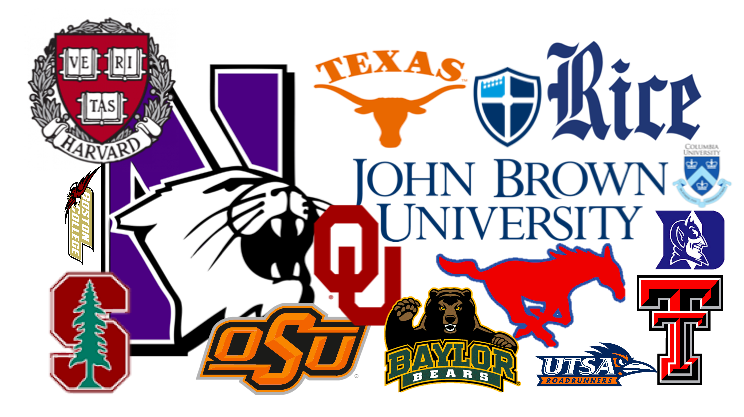Tall, modern buildings collide with gothic architecture as a frigid wind whistles across Lake Michigan just beyond the admissions building. An ornately curled arch proclaims the words NORTHWESTERN UNIVERSITY surrounded by leafless trees. Students bundled in scarves and beanies cradle their coffee close to themselves as they hurry across campus.
However, once stepping inside the Norris Center Student Union, the warm air and happy conversation creates an atmosphere of relaxation with its view of the now serene lake and ice skating rink. The smell of freshly baked bread intrigues the senses as students make their way over for a conversation about the latest basketball game. You smile to yourself. This feels like home.
Whether it be chilly Northwestern, sunny Stanford or lively Oklahoma State University, the atmosphere of a college is just as important as the academics. Because the college campus will be a student’s home for the next several years of their life, it’s important to be attentive on college visits in order to figure out which school feels like a fit.
It might not be required to visit a school in order to apply, but by doing so, a prospective student may learn about the classes that the school offers, where everything is on and off campus, hear from students directly and observe how campus life works. Another advantage of a visit is meeting other students from all around the country—and world—that are interested in the same studies and activities as you.
Students that have visited, or are currently attending the university, are the top source of information about the institution. They can offer helpful tips about the ins and outs of the university.
To get the most from a visit, have a list of goals and questions ready. Here are a few things to keep in mind:
Be observant.
Pay close attention to various things: what condition the dorms are in, how the cafeteria system works and even how the campus visually appears. Senior Jonathan Walsh, who visited Rice, Northwestern and the University of Texas at Austin, said, “Look at the dorms. The condition they are in shows how much the university cares about the students.” Visiting the Student Union gives a good perspective about student life on campus. Pay attention to signs and flyers about campus activities to see the interests of current students. Noticing the little things will make the college visit much more worthwhile and help confirm whether a college is a good fit.
Make sure to talk to professors around campus.
Since these professors determine success and failure, make sure they are professional and have teaching styles that promote learning. This is important, as many teachers can inhibit and hinder your full potential as a student. Consider teacher availability during both school hours and after class. Senior Bridgette Ocampo stressed the importance of visiting different classes of interest. She said, “I visited John Brown University, and they have a very good nursing school that I am interested in. They let me sit in on a nursing class the day that they set out mannequins that simulate giving birth. It was cool to see what an actual class looked like.”
Check classroom sizes of the school.
Class size and student-to-teacher ratio varies from school to school. Many colleges have classrooms with the capacity to fit hundreds of students in a lecture, while others accommodate only 10-20 students. The amount of people per class can certainly influence learning. A classroom with fewer students creates a more hands-on environment and better teacher-to-student relationship while larger classes allow more friendships to be made with peers.
“I personally like larger class sizes. That’s one reason why I liked A&M. I will get to meet more people and get to know a greater variety of people,” said Senior Luke Cione.
Pay attention to the layout of the college.
The layout of the college often indicates the priorities of the university. Colleges with more libraries and nicer classrooms may focus more on academics. Colleges with elite training facilities and expansive stadiums may focus more on athletics. Colleges with concert venues, theatre space and connections to Broadway may focus more on the fine arts. Research colleges before the visit to find out what they emphasize. Colleges also have different physical layouts. Some schools are spaced out and require some sort of transportation to reach far off buildings while others are smaller with all classes within walking distance of each other. Junior Wiley Green visited Stanford. He said, “I liked it a lot because it is very spread out and not crammed into a small campus. I like wide open spaces, so it felt right for me.”
Look at the campus’s location.
Whether adventure in the Rocky Mountains, chilling on Malibu Beach or discovering the windy city of Chicago appeals most, the college’s location, weather and demographics should play an important role in selection. Enjoy the snow and don’t mind the cold? Check out schools up north. However, if warm temperate weather appeals more, look to the south or west. Consider the living situation of colleges as well. Some schools require students to live on campus. Some send students abroad regularly. Also contemplate if you prefer college towns or city schools, as this affects the external environment and other opportunities in the future. For example, schools such as Columbia University located in New York City provide students with a metropolitan experience and unique opportunities. Because the school is near many major corporate headquarters, students have weekly speakers that come to discuss a wide variety of topics. Junior Julianne Works visited Columbia over spring break. She said, “Columbia is my dream school. The opportunities that it provides are unique because it is so close to downtown New York. I really hope to be able to attend someday.”
Pay attention to the campus life.
If you like sports teams and being involved in the stands, then check out colleges that offer big athletic programs. Find out if there is a marching band if interested or musically inclined. Some schools even provide student passes to all games. Keep in mind that if Greek life is appealing, you should check out the fraternity or sorority houses on your visit and request additional information.
“I can’t wait to go through recruitment when I get to college. Sororities and other campus life activities help you make friends that could last a life time and serve while having fun,” said Junior McKenzie Reynolds.
If exploring the city near the campus is a priority, make a mental note to ask about transportation between the campus and the city, or perhaps check out housing in the metropolitan area. If a slower pace of life suits the student, try schools out in the country and visit schools with close-knit college town communities. Ask around campus to see what students have to say about their communities and try to visualize living in that kind of environment.
Be open to suggestions and other possibilities.
Many colleges will open up new doors and introduce new possibilities to explore. Pay attention to detail. Listen. Some colleges may not always be the exact fit, but visiting them can help bring to light a new activity and feature to look for. For instance, a student may not currently be in to working out, but seeing that state-of-the-art rec center strikes a chord and suddenly that is now on the list of considerations for future college visits.
“I really liked Baylor because that’s where my parents wanted me to go. However, I visited Texas A&M and realized that was where I was supposed to be. If I didn’t keep touring even after I thought I had decided, I may have been going to Baylor in two years instead,” said Junior Evan Reyna.
Talking to other students about their visits can also help in deciding how you feel about a school. Juniors and Seniors are always happy to give advice. For example, Senior Bridgette Ocampo thought she was going to Texas A&M. Then, she visited John Brown University. She said, “A&M was great. However, it was a little overwhelming for someone like me who likes smaller schools. I never would’ve known if I didn’t visit.” So be open to the campus visit and be observant to assess the pros and cons of each school. As the guidance office always says, “You gotta go to know!”



